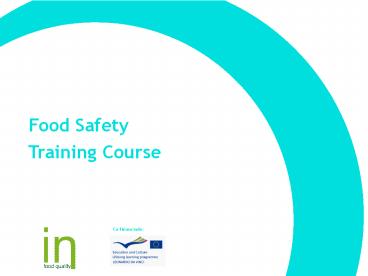HSA PowerPoint PPT Presentation
Title: HSA
1
Food Safety Training Course
2
Microorganisms and food
3
5 25 Microorganisms and food
- What are they?
- Main characteristics of living beings?
- Functions and applications?
Microorganisms
4
4 25 Microorganisms and food
- What do you understand by microbial growth?
- What factors affect microbial growth?
- How can we control the growth?
Microbial Growth
5
5 25 Microorganisms and food
Microbial Growth
Growth in optimum conditions
Growth in other situations
Time
Microbial growing stages in a liquid environment.
A Lag stage B- log stage C- stationary stage
and D- death stage
6
6 25 Microorganisms and food
- Intrinsic factors
- - Nutrients
- - pH
- - Water activity
- - Available oxygen
- Extrinsic factors
- - Temperature
- - Relative humidity
- - Atmospheric oxygen
- Other factors
- - Biological structures
- - Natural antimicrobial substances
Microbial growth factors
7
7 25 Microorganisms and food
Microbial growth factors - Temperature
Temperature Temperature is one of the most
relevant factors for microbial growth .
8
8 25 Microorganisms and food
- Main cause that lead to Intoxications
- Utilization of risk temperatures while
conserving food/meals - Utilization of inadequate temperatures while
preparing/processing those foods (under
processing)
Microbial growth factors - Temperature
9
9 25 Microorganisms and food
Microbial growth factors Hurdle effect
Adapted from Adams, M.R. and Moss, M.O., 1995
10
10 25 Microorganisms and food
- Main groups with importance for FS
- Bacteria
- Main characteristics
- Fungi (Molds and yeasts)
- Main characteristics
Microorganisms
11
11 25 Microorganisms and food
- Unicellular
- Various forms (cocci, bacilli, spirilla)
- Some develop resistant structures (spores)
- Main cause of food intoxications of biological
origin.
Bacteria
12
12 25 Microorganisms and food
Bacteria
Photos www.denniskunkel.com
13
13 25 Microorganisms and food
- Unicellular (yeasts)
- Multicellular (molds or filamentous fungi)
- Great decomposers of organic matter
- Widely used for making food and beverages
- Some are eatable (mushrooms)
- Responsible for deteriorating most fruits and
vegetables.
Fungi(molds and yeasts)
14
14 25 Microorganisms and food
Molds and yeasts
Some utilizations of fungi a) Some eatable
mushrooms. b) beer c) bread d) Roquefort
cheese with blue mold e) e f) Camembert an brie
cheeses (respectively) with white mold.
15
15 25 Microorganisms and food
Molds and yeasts
Mold on food
16
16 25 Microorganisms and food
- What are the sources of microorganisms that are
present on foods? - Soil
- Water
- Air
- Handlers
- Utensils and equipments
- Products themselves or raw materials used in
their fabrication.
Main sources
17
17 25 Microorganisms and food
- Soil
- Source of spore forming bacteria, fungi and
yeasts - Addition of manure faecal microorganisms
- Dissemination of microorganisms
- wind, rain, animals, fertilization
Main sources
18
18 25 Microorganisms and food
What measures should be taken to avoid/reduce
contamination?
Main sources
Table I Effect of washing on the flora of
vegetable products
Type of product Type of product Num. of microorganisms
Tomato Not washed gt 1 000 000/ cm2
Tomato Washed 400-700/cm2
Collards External leaves not washed 1 000 000 2 000 000/g
Collards Internal leaves washed 200 000 500 000/g
Collards Internal leaves 100 10 000/g
Data Jay, J.M., 1996 e Lacasse, D.. 1995.
19
19 25 Microorganisms and food
- Water
- - May contain various types of microorganisms
(origin and level of pollution) - - Utilization of potable water!
- How to avoid contamination?
Main sources
20
20 25 Microorganisms and food
- Air
- - Non favourable environment for microbial
growth - - Excellent conveyer of microorganisms from other
sources sneezing, coughing, agricultural
activities - How to reduce contamination caused by
microorganisms transmitted by air?
Main sources
21
21 25 Microorganisms and food
- Food
- Diverse and proper flora
- Vegetables
- Animals
Main sources
22
22 25 Microorganisms and food
- Handlers
- Diverse and own flora (faecal matter and skin)
- Main problems?
- Utensils and Equipments
- - Do not have own microflora
- Main cause of
- CROSS CONTAMINATIONS!!!
Main sources
23
23 25 Microorganisms and food
- What is cross contamination?
- Microorganisms present in raw foods, utensils
and contaminated surfaces are transferred to
prepared or washed foods or to clean surfaces.. - - What are the main conveyers?
- - How to prevent/avoid?
- - Examples
Cross contamination
24
24 25 Microorganisms and food
- Difference between Hazard and Risk
- - What is the origin of hazards?
- - Examples
Risks and hazards
25
25 25 Microorganisms and food
Riscos e Perigos
Table II Classification of hazards related to
food safety
Types of hazards Examples of hazards Examples of associated foods Potential illnesses
Salmonella Eggs, poultry, raw milk and milk products Salmonellosis
Hepatitis A virus Fish, seafood, vegetables, water, fruit, milk Hepatitis A
Bones, fish bones, glass, metal, stones Lesions
Aflotoxins Nuts, corn, milk and milk products Cancer, malformations, alterations of the nervous system diseases hormonal alterations
Dioxins Fish, animal fat Cancer, malformations, alterations of the nervous system diseases hormonal alterations

